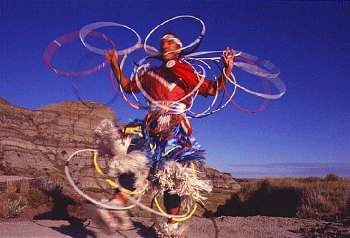|
|
Canku Ota |
|
|
(Many Paths) |
||
|
An Online Newsletter Celebrating Native America |
||
|
May 4 , 2002 - Issue 60 |
||
|
|
||
|
Kevin Locke |
||
|
by Jamie Lockard
|
||
|
credits:
Photo Kevin Locke performing the hoop dance courtesy
|
|
Have you have ever heard the sound of the Indian love songs played on the flute? Its gentle, flowing melodies dancing on the wind. Seven notes sing out in the old Lakota-Dakota style welcoming the spring and waking the spirit of the earth. This is the Niya Awicableze, the Enlightened Breath. If you have heard it, then you may have heard Kevin Locke. Kevin Locke's Lakota name is Tokeya Inajin, which means “First to Arise”. He is known as the man who revived the Lakota courting flute. The art of the courting flute had all but died out when Kevin found an old flute in his mother’s attic. With help from elders, who taught him the old ways and from old recordings from the Library of Congress, he taught himself to play. At the time, there was only one other player of the traditional way. In 1980, the United States Information Agency asked Kevin to tour. Since then, Kevin has sold more than 200,000 copies of his recordings, been to more than 65 countries and won the most prestigious award from the National Endowment for the Arts--The National Heritage Fellowship. Tokeka Inajin is also known for re-introduction of the Hoop Dance. It too had almost died out when Arlo Good Bear, a Mandan Hidatsa Indian from North Dakota, began teaching Kevin. Arlo was able to give Kevin one lesson before he died in an accident. Kevin believes Arlo gave him the other lessons through very vivid dreams. The hoop dance is a very powerful, very beautiful dance. Each of the colored hoops represent a different thing, the four elements, the four winds, and the four races. Kevin teaches the dance everywhere he goes. Traditionally, the dance was done by men, but Kevin believes that the dance is for everyone as it represents unity. Kevin is a very talented man who taught himself the Lakota language at an early age, although it was still illegal to speak it. He began learning from his elderly uncle, Abraham End of Horn. He would pester the old ones into teaching him words he didn’t know and the correct pronunciation. The people of the northern plains of Maka Wita (Earth Island), owe much to Kevin Locke, as do Native Americans everywhere, he has done much for our people. Through music and the hoop dance, he makes our culture and heritage known throughout the world and teaches the young ones about the past. He has done much to take the Native American arts outside the Pow-Wow arena. Kevin once said, "I see that the Lakota people have many gifts to bring to the world. The people are desperate for these gifts. We know that human kind is in a crisis. Now we need to draw from all of these wellsprings of knowledge that are within the treasures of the hearts of the peoples of the world." Tokeya Inajin still lives in the Wakpala district of the Standing Rock Reservation near Mobridge, South Dakota. He still tours and perhaps best of all, he still loves teaching children.
|
|
|
|
||
|
|
||
| Canku Ota is a free Newsletter celebrating Native America, its traditions and accomplishments . We do not provide subscriber or visitor names to anyone. Some articles presented in Canku Ota may contain copyright material. We have received appropriate permissions for republishing any articles. Material appearing here is distributed without profit or monetary gain to those who have expressed an interest. This is in accordance with Title 17 U.S.C. Section 107. | ||
|
Canku Ota is a copyright © 2000, 2001, 2002, 2003 of Vicki Lockard and Paul Barry. |
||
 |
 |
|
|
The "Canku Ota - A Newsletter Celebrating Native America" web site and its design is the |
||
|
Copyright © 1999, 2000, 2001, 2002, 2003 of Paul C. Barry. |
||
|
All Rights Reserved. |
||
 As
the steady heartbeat of the drum speaks, a lone man dances the dance
of the hoop, inside the sacred arena. Twenty-eight hoops in all,
four different colors, all lace together, making the shapes of spring.
Flowers, stars, birds, butterflies, and even the moon, appear in
the hoops. If you’ve ever seen this, then you have probably seen
Kevin Locke.
As
the steady heartbeat of the drum speaks, a lone man dances the dance
of the hoop, inside the sacred arena. Twenty-eight hoops in all,
four different colors, all lace together, making the shapes of spring.
Flowers, stars, birds, butterflies, and even the moon, appear in
the hoops. If you’ve ever seen this, then you have probably seen
Kevin Locke.